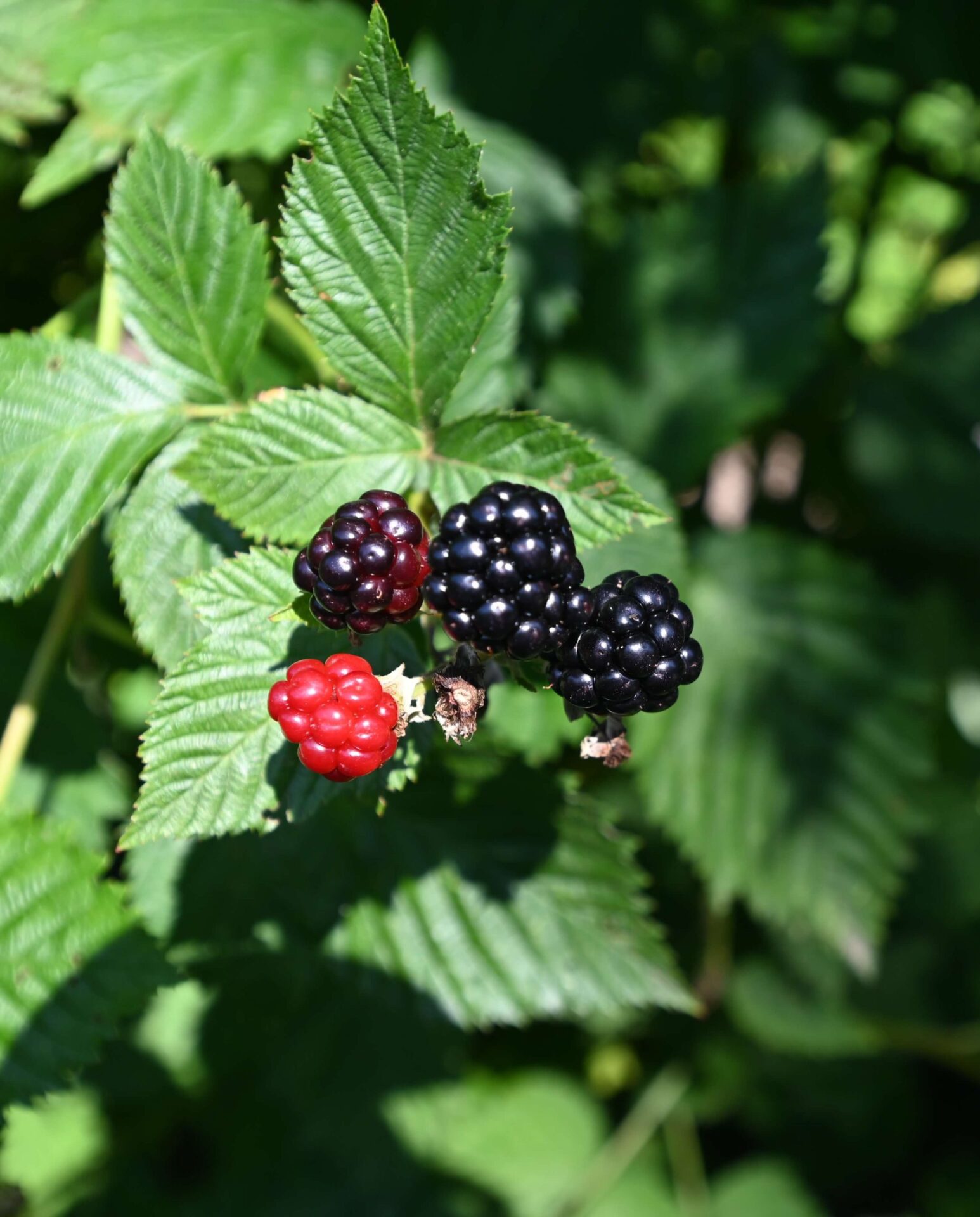
[et_pb_section fb_built=”1″ admin_label=”section” _builder_version=”4.16″ da_disable_devices=”off|off|off” global_colors_info=”{}” da_is_popup=”off” da_exit_intent=”off” da_has_close=”on” da_alt_close=”off” da_dark_close=”off” da_not_modal=”on” da_is_singular=”off” da_with_loader=”off” da_has_shadow=”on”][et_pb_row admin_label=”row” _builder_version=”4.16″ background_size=”initial” background_position=”top_left” background_repeat=”repeat” global_colors_info=”{}”][et_pb_column type=”4_4″ _builder_version=”4.16″ custom_padding=”|||” global_colors_info=”{}” custom_padding__hover=”|||”][et_pb_text _builder_version=”4.25.1″ _module_preset=”default” global_colors_info=”{}”]
Growing and Harvesting Berries at Home
[/et_pb_text][et_pb_text _builder_version=”4.25.1″ _module_preset=”default” text_text_color=”#000000″ link_font=”|700|||on|||#000000|” link_text_color=”#000000″ global_colors_info=”{}”]
Welcome to summer berry harvesting season, where you can enjoy flavorful fruit straight from your own backyard with minimal time and effort!
Many types of berries are considered perennial in Philadelphia’s climate, meaning they can survive the winter and will continue to provide harvests another year. In addition, perennials support beneficial pollinators and require less overall maintenance than annual gardens, making them an ideal choice for busy gardeners and sustainability enthusiasts alike.
Once you’ve experienced the joy of plucking ripe berries straight from the vine, instead of buying mushy or overpriced grocery store produce, you’ll appreciate the difference! With Backyard Eats, even beginners can successfully learn how to grow and harvest berries at home. Here’s a quick guide on when to harvest your berries this summer:
[/et_pb_text][et_pb_text _builder_version=”4.25.1″ _module_preset=”default” global_colors_info=”{}”]
Types of Berries to Grow
[/et_pb_text][/et_pb_column][/et_pb_row][et_pb_row column_structure=”2_5,3_5″ _builder_version=”4.25.1″ _module_preset=”default” custom_margin_tablet=”” custom_margin_phone=”0px||||false|false” custom_margin_last_edited=”on|phone” custom_padding=”0px||||false|false” global_colors_info=”{}”][et_pb_column type=”2_5″ _builder_version=”4.25.1″ _module_preset=”default” global_colors_info=”{}”][et_pb_image src=”https://backyard-eats.com/wp-content/uploads/2023/06/pexels-aphiwat-chuangchoem-365839.jpg” title_text=”pexels-aphiwat-chuangchoem-365839″ _builder_version=”4.25.1″ _module_preset=”default” global_colors_info=”{}”][/et_pb_image][/et_pb_column][et_pb_column type=”3_5″ _builder_version=”4.25.1″ _module_preset=”default” global_colors_info=”{}”][et_pb_text _builder_version=”4.27.0″ _module_preset=”default” text_text_color=”#000000″ link_font=”|700|||on|||#000000|” link_text_color=”#000000″ hover_enabled=”0″ global_colors_info=”{}” sticky_enabled=”0″ header_2_font_size_last_edited=”on|phone” header_2_font_size_phone=”24px” header_2_line_height=”1.5em”]
Growing Strawberries
Strawberries are a popular choice. Unlike blackberries, which grow on bushes, strawberries are groundcover plants that typically grow less than a foot tall. Because they reproduce by sending out “runners,” we recommend dedicating an entire raised bed to growing strawberries so they don’t interfere with other plants.
[/et_pb_text][/et_pb_column][/et_pb_row][et_pb_row column_structure=”2_5,3_5″ _builder_version=”4.25.1″ _module_preset=”default” custom_margin_tablet=”” custom_margin_phone=”0px||||false|false” custom_margin_last_edited=”on|phone” custom_padding=”0px||||false|false” global_colors_info=”{}”][et_pb_column type=”2_5″ _builder_version=”4.25.1″ _module_preset=”default” global_colors_info=”{}”][et_pb_image src=”https://backyard-eats.com/wp-content/uploads/2024/05/jo-anaya-LTXXsbV_N9k-unsplash.jpg” title_text=”jo-anaya-LTXXsbV_N9k-unsplash” _builder_version=”4.25.1″ _module_preset=”default” global_colors_info=”{}”][/et_pb_image][/et_pb_column][et_pb_column type=”3_5″ _builder_version=”4.25.1″ _module_preset=”default” global_colors_info=”{}”][et_pb_text _builder_version=”4.27.0″ _module_preset=”default” text_text_color=”#000000″ link_font=”|700|||on|||#000000|” link_text_color=”#000000″ global_colors_info=”{}” sticky_enabled=”0″ header_2_line_height=”1.5em” header_2_font_size_phone=”24px” header_2_font_size_last_edited=”on|phone”]
Growing Cane Fruit
Blackberries and raspberries, on the other hand, are cane fruit. This means that a plant develops several branches (“canes”) from a central crown. These canes spread and get heavy as they grow taller, requiring the support of a wire berry trellis. Seasonal pruning will help keep blackberry and raspberry plants healthy and manageable. Blackberry canes develop new growth in spring and typically fruit in their second and third years before dying off. Ever-bearing varieties of raspberries typically produce new canes in spring, fruit in the fall on the tips of canes, and fruit again in the next spring before dying during their second fall. This cycle continues with new canes each year.
[/et_pb_text][/et_pb_column][/et_pb_row][et_pb_row column_structure=”2_5,3_5″ _builder_version=”4.25.1″ _module_preset=”default” custom_margin_tablet=”” custom_margin_phone=”0px||||false|false” custom_margin_last_edited=”on|phone” custom_padding=”0px||||false|false” global_colors_info=”{}”][et_pb_column type=”2_5″ _builder_version=”4.25.1″ _module_preset=”default” global_colors_info=”{}”][et_pb_image src=”https://backyard-eats.com/wp-content/uploads/2023/06/pexels-андрей-архипов-5140042-1.jpg” title_text=”pexels-андрей-архипов-5140042 (1)” _builder_version=”4.25.1″ _module_preset=”default” global_colors_info=”{}”][/et_pb_image][/et_pb_column][et_pb_column type=”3_5″ _builder_version=”4.25.1″ _module_preset=”default” global_colors_info=”{}”][et_pb_text _builder_version=”4.27.0″ _module_preset=”default” text_text_color=”#000000″ link_font=”|700|||on|||#000000|” link_text_color=”#000000″ global_colors_info=”{}” sticky_enabled=”0″ header_2_line_height=”1.5em” header_2_font_size_phone=”24px” header_2_font_size_last_edited=”on|phone”]
Growing Bush Fruit
Bush fruit, like the name suggests, are varieties of berries that grow on bushes instead of in patches or on canes. Perennial bush berries we recommend to Backyard Eats clients include blueberries, currants, elderberries, gooseberries, and serviceberries. These crops are all native to North America and suited to our climate. While you might not find options like elderberries in the grocery store, they offer unique flavors and functional benefits for the permaculture gardeners. Typically, these plants do not require a trellis for support.
[/et_pb_text][/et_pb_column][/et_pb_row][et_pb_row admin_label=”row” _builder_version=”4.16″ background_size=”initial” background_position=”top_left” background_repeat=”repeat” global_colors_info=”{}”][et_pb_column type=”4_4″ _builder_version=”4.16″ custom_padding=”|||” global_colors_info=”{}” custom_padding__hover=”|||”][et_pb_text _builder_version=”4.25.1″ _module_preset=”default” global_colors_info=”{}”]
When to Harvest Berries
[/et_pb_text][et_pb_text _builder_version=”4.27.0″ _module_preset=”default” text_text_color=”#000000″ link_font=”|700|||on|||#000000|” link_text_color=”#000000″ global_colors_info=”{}” sticky_enabled=”0″ header_2_line_height=”1.5em” header_2_font_size_phone=”24px” header_2_font_size_last_edited=”on|phone”]
When to Harvest Strawberries
Ever-bearing varieties of strawberries can produce fruit all summer, while June-bearing varieties will fruit for a couple of weeks in midsummer (late May-early June) and not again until next year. Keep your eyes out for those classic red berries!
[/et_pb_text][et_pb_text _builder_version=”4.27.0″ _module_preset=”default” text_text_color=”#000000″ link_font=”|700|||on|||#000000|” link_text_color=”#000000″ global_colors_info=”{}” sticky_enabled=”0″ header_2_line_height=”1.5em” header_2_font_size_phone=”24px” header_2_font_size_last_edited=”on|phone”]
When to Harvest Cane Fruit
Raspberries are typically ready to harvest in summer to early fall, with a peak harvest in early July. Ripe raspberries will have vibrant color and a soft texture. Always harvest in the morning for the best texture and flavor. You may find gloves helpful to avoid thorns. Blackberries follow a similar schedule, with a peak harvest typically from July to August. For multiple harvests, consider ever-bearing varieties that fruit in summer and fall.
[/et_pb_text][/et_pb_column][/et_pb_row][et_pb_row column_structure=”1_2,1_2″ _builder_version=”4.27.0″ _module_preset=”default” custom_margin_tablet=”||-20px||false|false” custom_margin_phone=”0px||0px||false|false” custom_margin_last_edited=”on|phone” custom_padding=”0px||0px||false|false” hover_enabled=”0″ global_colors_info=”{}” sticky_enabled=”0″][et_pb_column type=”1_2″ _builder_version=”4.25.1″ _module_preset=”default” global_colors_info=”{}”][et_pb_image src=”https://backyard-eats.com/wp-content/uploads/2023/06/DSC_0278-copy-scaled.jpg” title_text=”DSC_0278 copy” _builder_version=”4.25.1″ _module_preset=”default” global_colors_info=”{}”][/et_pb_image][/et_pb_column][et_pb_column type=”1_2″ _builder_version=”4.25.1″ _module_preset=”default” global_colors_info=”{}”][et_pb_image src=”https://backyard-eats.com/wp-content/uploads/2023/05/Copy-of-DSC_7469-scaled.jpg” title_text=”Copy of DSC_7469″ disabled_on=”on|on|off” _builder_version=”4.25.1″ _module_preset=”default” global_colors_info=”{}”][/et_pb_image][/et_pb_column][/et_pb_row][et_pb_row admin_label=”row” _builder_version=”4.25.1″ background_size=”initial” background_position=”top_left” background_repeat=”repeat” custom_margin_tablet=”” custom_margin_phone=”0px||||false|false” custom_margin_last_edited=”on|phone” global_colors_info=”{}”][et_pb_column type=”4_4″ _builder_version=”4.16″ custom_padding=”|||” global_colors_info=”{}” custom_padding__hover=”|||”][et_pb_text _builder_version=”4.27.0″ _module_preset=”default” text_text_color=”#000000″ link_font=”|700|||on|||#000000|” link_text_color=”#000000″ global_colors_info=”{}” sticky_enabled=”0″ header_2_line_height=”1.5em” header_2_font_size_phone=”24px” header_2_font_size_last_edited=”on|phone”]
When to Harvest Bush Fruit
These perennial berries are typically ready to harvest in mid-summer, but have unique signs they’re ready to harvest depending on the variety.
As their name suggests, Juneberries (serviceberries) are one of the first berries to ripen in summer besides strawberries. They are typically ready to harvest from May to June. Like blueberries, they begin as a green or pink color and should be a dark purple or blue color when fully ripe.
Blueberries can ripen in late June, but typically peak in early-mid July. Wait until they’re firm, have a dusty blue color, and separate easily from the branch. Enjoy fresh or freeze to enjoy in the off-season!
Currants and gooseberries both follow a similar schedule (June-July) and come in a variety of colors. Understand which variety you’re growing; harvest when berries are colorful and slightly soft when squeezed but not mushy.
Elderberries develop clusters of deep purple/black berries when ripe. Most berries from a cluster should ripen together in August and September. Note that elderberries are small, bitter, and potentially dangerous when consumed raw.
[/et_pb_text][et_pb_cta button_url=”https://backyard-eats.com/book-a-consultation-step-one/” button_text=”BOOK A CONSULTATION” disabled_on=”off|off|off” _builder_version=”4.27.0″ _module_preset=”default” body_link_font=”|700|||on|||#FFFFFF|” body_link_text_color=”#FFFFFF” background_color=”#88667B” custom_button=”on” text_orientation=”left” custom_margin=”20px||||false|false” custom_margin_tablet=”20px||||false|false” custom_margin_phone=”20px||||false|false” custom_margin_last_edited=”on|tablet” hover_enabled=”0″ header_line_height_tablet=”” header_line_height_phone=”1em” header_line_height_last_edited=”on|phone” button_text_size_tablet=”” button_text_size_phone=”16px” button_text_size_last_edited=”on|phone” global_colors_info=”{}” sticky_enabled=”0″]
For more information on how and when to harvest your summer berries, visit our Harvest Toolkit for expert advice including storage instructions and recipe ideas! If you’re inspired to grow berries at home, book a consultation today to learn how Backyard Eats can help you design, build, and maintain a productive edible landscape.
[/et_pb_cta][/et_pb_column][/et_pb_row][/et_pb_section]






